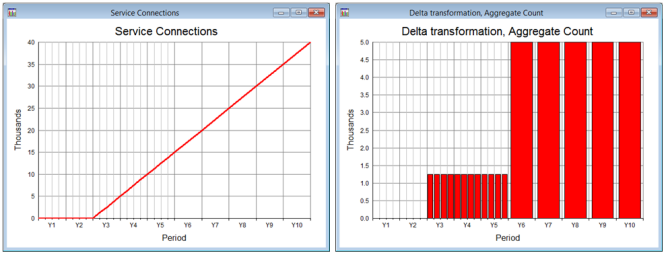The Delta transformation finds the aggregate equivalent of an instantaneous output by finding (for each time period) the difference between the current instantaneous value (at the end of the time period) and the previous instantaneous value (the start of the time period).

Figure 1: Delta transformation dialog
The input of the Delta transformation is the output of another transformation, service or resource, and must be an instantaneous basis, such as a number of connections. STEM will not let you use an aggregate input basis.
You can define an Initial Input, which serves as the previous instantaneous value for the first period, which STEM will use to calculate the first aggregate value.
Like other transformations, there are optional Multiplier and Output Unit inputs that can be used if required.
Simple example
An example output is shown in Figure 2 below. The input (on the left) is an instantaneous value with constant growth starting at the end of Y2 (beginning of Y3), and increasing by 5000 per year. Note that by default a graph showing an instantaneous value is a line graph, signifying the value changing continuously over time.
The output (on the right) is an aggregate value showing the growth over each period: 1250 in each quarter from Y3 to Y5, and 5000 in each year from Y6. Note that by default a graph showing a cumulative value is a column bar graph, so that each column shows the aggregate over the corresponding period.

Figure 2: The output of the Delta transformation (right) for the given input (left)
Example 2
Let’s assume you need the net change in subscriber numbers in your model to be an aggregate measure. Using Basis
= New Connections in transformations would contain churn and not allow negative numbers, so you need to calculate the difference between total subscriber numbers. A combination of a Previous transformation and an expression would provide an instantaneous measure, so a Delta transformation would be more convenient for this purpose.